Total phenolic, flavonoid, protein contents and biological activities of wild mustard
IF 1
4区 农林科学
Q4 FOOD SCIENCE & TECHNOLOGY
引用次数: 0
Abstract
The nutritional and therapeutic benefits of plants are outstanding. Wild mustard (Sinapis arvensis L.) collected from different regions was analysed for its phenolic, flavonoid, protein, and biological activity levels. In this case, the plant ethanol extract was obtained using a soxhlet apparatus. Rel assay kits and the DPPH test were used to assess the plant's antioxidant activity. The agar dilution test was used to determine antimicrobial efficacy. A549 lung cancer cells were used in an MTT assay to measure antiproliferative activity. The Folin−Ciocalteu reagent was used to quantify the total phenolic content of the sample. The amount of flavonoids was determined using an aluminium chloride test. The amount of protein was calculated using the AOAC's standard technique. Based on the research conducted, it was shown that the maximum total antioxidant status (TAS) value for the ethanol extract of wild mustard from various places was 5.232 ± 0.047 mmol L−1. At a concentration of 2 mg mL−1, DPPH activity was measured to be 82.06 ± 1.01. The maximum levels of total phenolic, flavonoid, and protein were 80.57 ± 2.19 mg g−1, 154.07 ± 2.79 mg g−1, and 7.75 ± 0.24%, respectively. Doses of 25–100 μg mL−1 of plant extracts were effective against fungal strains, whereas doses of 50–200 μg mL−1 were beneficial against bacterial strains. The plant extracts were shown to have potent antiproliferative properties. It was found that wild mustard's phenolic, flavonoid, protein, and biological activity levels varied according to the location from which it was gathered. It was also concluded that wild mustard had significant biological activity.野生芥菜总酚、类黄酮、蛋白质含量及生物活性
植物的营养和治疗效益是突出的。对不同产地的野生芥菜(Sinapis arvensis L.)的酚类、类黄酮、蛋白质和生物活性进行了分析。在这种情况下,使用索氏装置获得植物乙醇提取物。采用Rel测定试剂盒和DPPH法测定植株的抗氧化活性。采用琼脂稀释法测定其抑菌效果。用MTT法测定A549肺癌细胞的抗增殖活性。采用Folin - Ciocalteu试剂定量测定样品中总酚含量。采用氯化铝法测定黄酮类化合物的含量。用AOAC的标准技术计算蛋白质的量。研究表明,各地野芥菜乙醇提取物的最大总抗氧化状态(TAS)值为5.232±0.047 mmol L−1。浓度为2 mg mL−1时,DPPH活性为82.06±1.01。总酚、类黄酮和蛋白质的最高含量分别为80.57±2.19 mg g−1、154.07±2.79 mg g−1和7.75±0.24%。25 ~ 100 μ mL−1的剂量对真菌菌株有效,而50 ~ 200 μ mL−1的剂量对细菌菌株有益。植物提取物被证明具有有效的抗增殖特性。发现野生芥菜的酚类、类黄酮、蛋白质和生物活性水平随采集地点的不同而变化。结果表明,野生芥菜具有显著的生物活性。
本文章由计算机程序翻译,如有差异,请以英文原文为准。
求助全文
约1分钟内获得全文
求助全文
来源期刊

Acta Alimentaria
农林科学-食品科技
CiteScore
1.80
自引率
0.00%
发文量
47
审稿时长
18-36 weeks
期刊介绍:
Acta Alimentaria publishes original papers and reviews on food science (physics, physical chemistry, chemistry, analysis, biology, microbiology, enzymology, engineering, instrumentation, automation and economics of foods, food production and food technology, food quality, post-harvest treatments, food safety and nutrition).
 求助内容:
求助内容: 应助结果提醒方式:
应助结果提醒方式:


